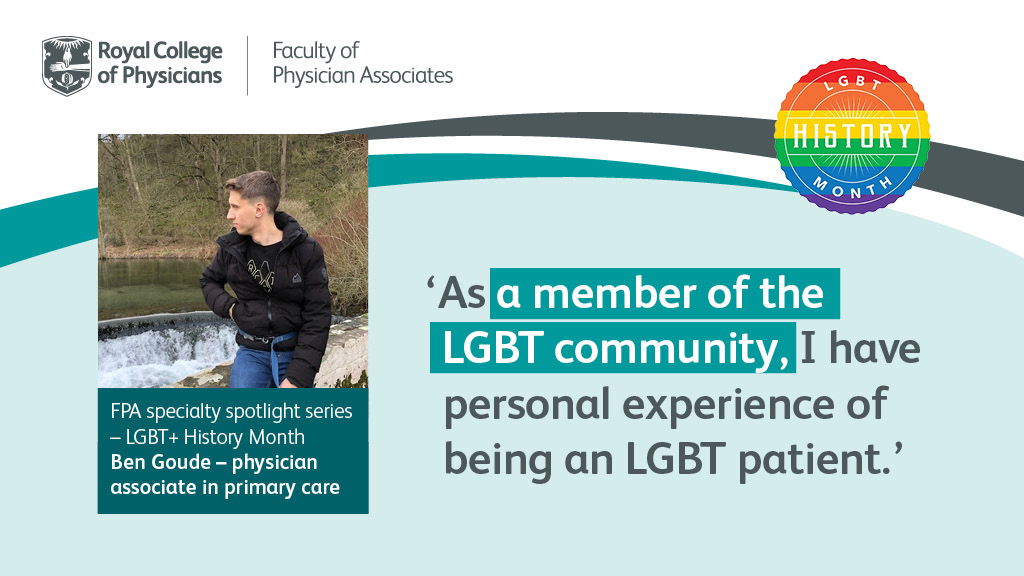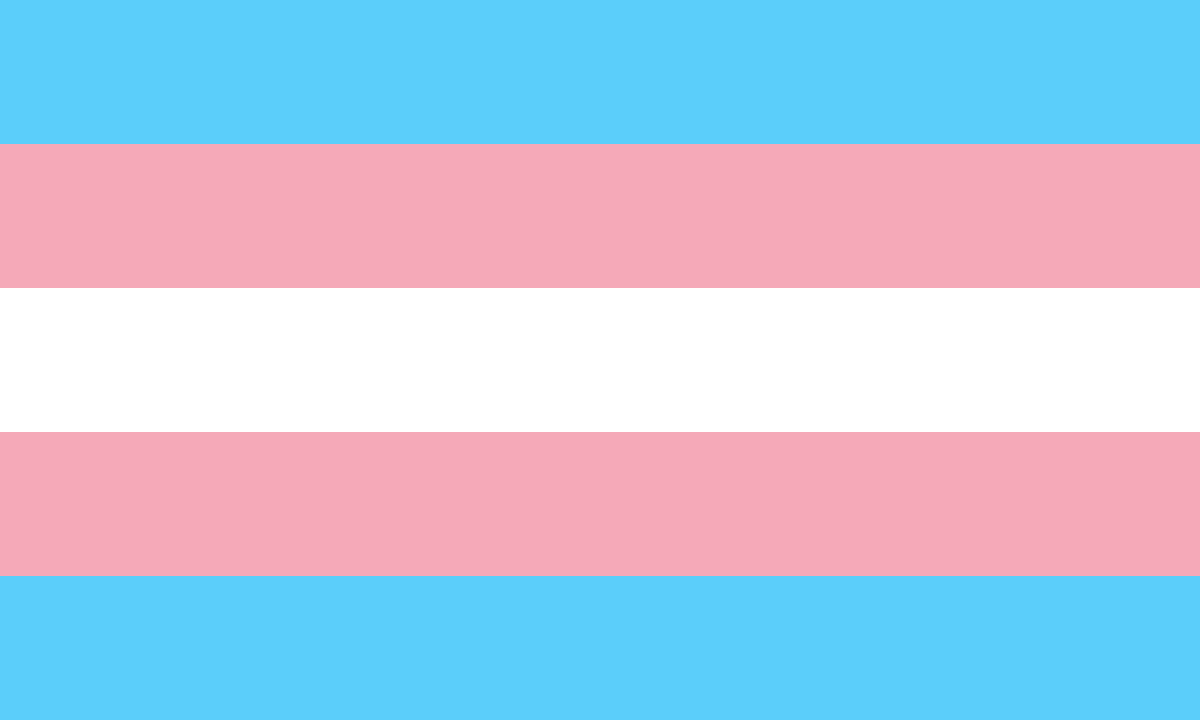LGBT+ History Month – a physician associate’s experience of supporting LGBT patients
Lesbian Gay Bisexual and Transgender (LGBT) History Month aims to promote equality and diversity while educating and raising awareness of LGBT communities. In the UK, more people than ever identify as an LGBT individual,1 meaning it’s vital that healthcare providers and professionals provide an inclusive environment for these patient groups.
Physician associate Ben Goude qualified from the University of Sheffield in 2020. Ben currently works in primary care, with an interest in LGBT+ healthcare and sexual health. In this article, he shares how he supports LGBT patients and highlights the importance of offering an inclusive environment.
As a PA, what is your experience of working with LGBT patients, and how do you support them?

As a member of the LGBT community, I have personal experience of being an LGBT patient. Some of the encounters I have had with health professionals have not always been the most comfortable. For example, my sexuality has been assumed, as has the gender of my partner. I have tried to learn from these experiences to better support my LGBT patients as a PA in primary care. Regardless of where we work as PAs, we will always encounter diversity, including gender identity and sexuality. We might not always be aware each patient’s circumstances – and it may not be relevant to the consultation – but by approaching all patients with the same non-judgemental and open approach, we can ensure an inclusive environment for everyone.
I remember a consultation I had with a patient who identified as trans [an individual whose gender identity is different from their birth gender]. Their identity was not what made the consultation memorable, but to my knowledge it was the first time they had spoken openly about their identity to a healthcare professional. As a newly qualified PA, I felt honoured, and I had a great sense of responsibility to ensure this was a positive experience for them. We know from research by Stonewall that around one-in-seven LGBT people avoid seeking healthcare because they fear discrimination. It's vital that we collectively try to reduce this by providing positive, non-judgemental care to everyone we see. Working in primary care, I also help with the management of patients who are cared for by the local Gender Identity Clinic. My primary role in this is to action blood results and clinic letters, as patients who are on hormone replacement therapy require frequent blood monitoring.
As well as my role in primary care, I’m also studying for the Faculty of Sexual and Reproductive Health Diploma (DFSRH). This has been an excellent experience for improving my general communication and consultation skills, which translates into providing good sexual healthcare for all individuals, including those in the LGBT community. One aspect to ensuring inclusive healthcare, in sexual health and beyond, is to choose our language carefully. Assumptions shouldn’t be made about an individual’s identity, or the identity of their partner(s) – we can avoid this by using gender-neutral pronouns when asking about partners, or the type of sex the individual has.
How inclusive is the primary care setting for LGBT patients? What can PAs do to support/improve this?

I think that the inclusivity of a care setting can only be properly evaluated by those who access the service, but in our role as PAs we can make positive changes to improve this. When thinking about how we can help foster an environment in which LGBT individuals are able to seek healthcare without fear of discrimination, I like to imagine the entire patient journey. This begins with the patient making their appointment, continuing through to the physical consultation with the clinician. The first encounter for a patient in primary care is usually with a receptionist, whether to register as a new patient or to book an appointment. Receptionists do an amazing job under a vast amount of pressure, and therefore systems need to be set up in a way that helps them to easily incorporate LGBT inclusivity into their role. For example, ensuring pronouns and gender identity are displayed clearly and sensitively in patients' records to prevent patients from being misgendered. Training is also important so that all staff, regardless of role, have the knowledge to promote LGBT inclusivity.
Once in the practice, consider what inclusive material is visible. Are there posters or leaflets about LGBT health, or is it all heteronormative? Are the toilets gendered? If so, do both male and female toilets have waste disposal bins for sanitary products? When a patient checks in for their appointment, is there an automated system that requires them to state their gender? Does the screen in the waiting room display titles as well as names? All these factors might seem small, perhaps even inconsequential, because for many of us they are so ingrained that we don’t think to question them. However, if we really want to make an inclusive environment, they are exactly the things we need to address.
Finally, and perhaps where we can make the biggest impact as PAs, is in the consultation room. How LGBT aware do you consider yourself to be? I think that LGBT issues within healthcare are generally undertaught and under-researched, and there appears to be great variability in the knowledge base of clinically trained staff on LGBT healthcare. This inevitably results in greater variability in the inclusivity and accessibility of primary care settings. By taking personal responsibility for our own learning, we can then help educate those we work with, so that patients have a good experience throughout our service.
What advice would you want to share with your fellow PAs to ensure LGBT patients have a positive experience?

The language you use is one of the most important factors in deciding whether the patient has a consultation that is positive and affirming, versus one that could be uncomfortable and demoralising. If you don’t know which pronoun to use – ask! Be mindful of who the patient is with, as this may impact how comfortable or safe they feel in disclosing certain facets about their identity. Being open and non-judgemental should be a core element of all your consultations, but it is particularly important when we see patient groups who are more likely to face stigma and judgment. Consider how you can personally display your allyship, such as wearing the LGBT rainbow badge and the transgender pride flag badge, and think more broadly about how you can make the area you work visibly inclusive to LGBT patients.
It’s important to stress that while people often think of LGBT health in relation to sexual health, there are lots of other health inequalities, such as substance misuse, housing, and mental health. In our consultations, we should consider the support that our patients have around them and whether they are able to express their identity safely or not. Thinking more broadly still, we should remain mindful of the wider societal and cultural factors that influence marginalised groups, and how these can have specific impacts on health.
Finally, whether you’re a qualified PA or a student, why not seek out resources for your own learning and CPD to develop your knowledge and improve your abilities to have a positive impact on LGBT patients. St George’s recently released a free online course, entitled ‘Transgender Healthcare: Caring for Trans Patients’. There are other resources out there too such as Mermaids, Stonewall, TransActual, and guidance from the General Medical Council and Care Quality Commission.
What does the future look like for you as a PA, and how will you continue to improve the support provided to LGBT patients?
I am hoping to complete the DFSRH this year. I have already learned so much from spending time in the clinic with colleagues in the sexual health service. I am enjoying furthering my knowledge and developing my consultation skills, which I feel has already helped me in my primary care role. I’d highly recommend the course to all my primary care PA colleagues.
I have also spoken to some university colleagues who are trying to make their PA curriculum more inclusive and have offered them some guidance regarding LGBT teaching. Dreaming big, it would be fantastic to develop a community-based PA-run service to help support gender identity clinics by increasing patient access and reducing clinic waiting times.
1 Reuters 2021, accessed 02.03.2022, <https://www.reuters.com/article/us-britain-lgbt-stats-idUSKCN2D90VK>
